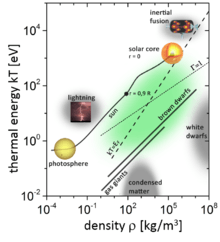Warm dense matter

Warm dense matter, abbreviated WDM, can refer to either equilibrium or non-equilibrium states of matter in a (loosely defined) regime of temperature and density between condensed matter and hot plasma. It can be defined as the state that is too dense to be described by weakly coupled plasma physics yet too hot to be described by condensed matter physics. In this state, the potential energy of the interaction between electrons and nuclei and the kinetic energy of electrons are of roughly the same magnitude. The temperature is of the order of the Fermi energy. A commonly occurring WDM, created using ultra-fast laser pulses, may exist for a short time in a two-temperature quasi-equilibrium form where the electrons are very hot and have a temperature different from the ions. WDM has a density of the same order of magnitude as a solid (typically somewhere between 0.01 and 100 grams per cc) and a temperature on the order of a few tens of thousands of kelvins (typically somewhere between 1 and 100 electronvolts/Boltzmann constant, in the units favored by practitioners). In effect, WDM is a sub-category of warm-correlated matter.
WDM is expected in the cores of some large planets, in the inertial confinement fusion context during the solid to plasma phase transition driven by laser pulses, and other systems that start as solids and are heated to become strongly interacting plasmas.[1] The latter two categories imply that WDM physics are also relevant not only to nuclear explosions, but also to space re-entry tiles, ablation of metals, laser-machining of materials etc. In effect, warm dense matter is also created during intense laser-target interactions[2] and particle beam-target interactions.[3]